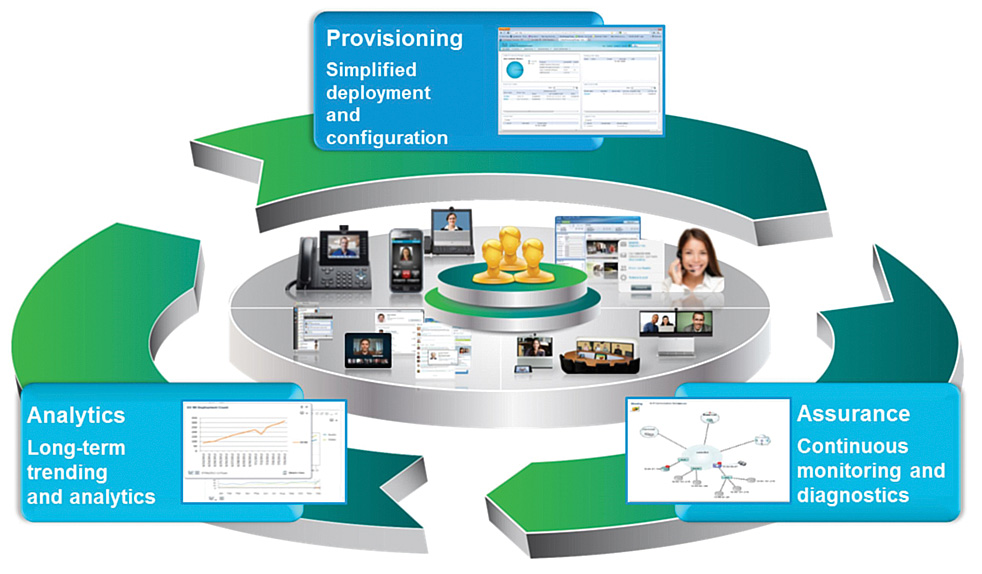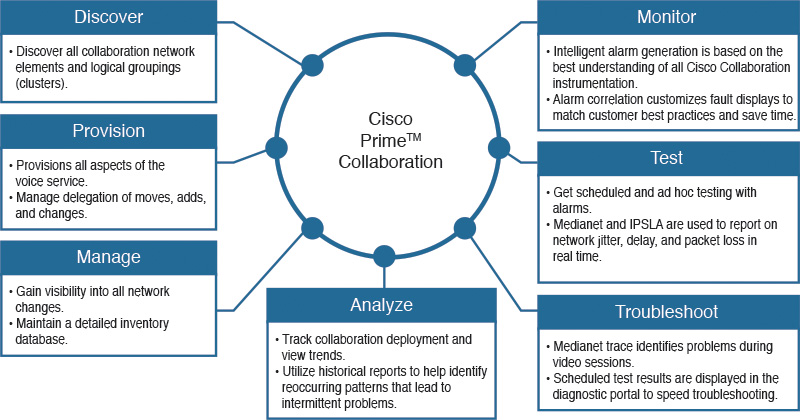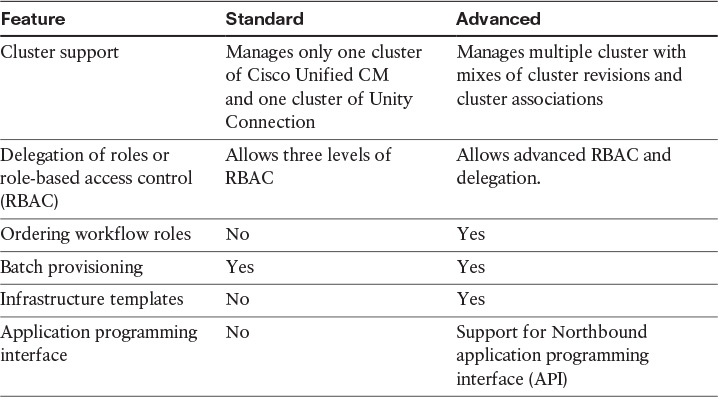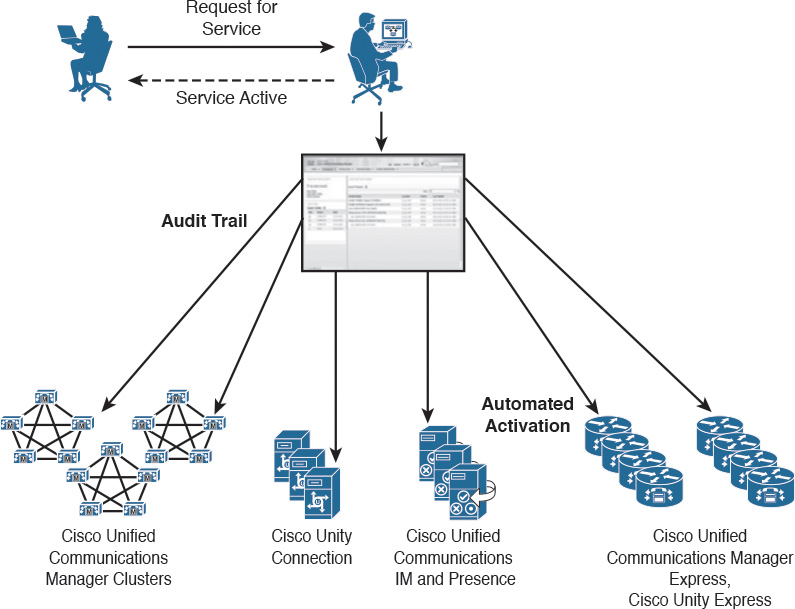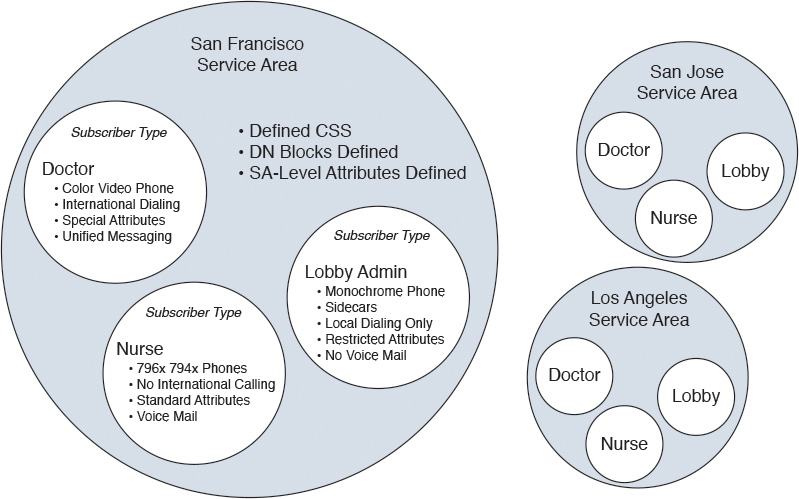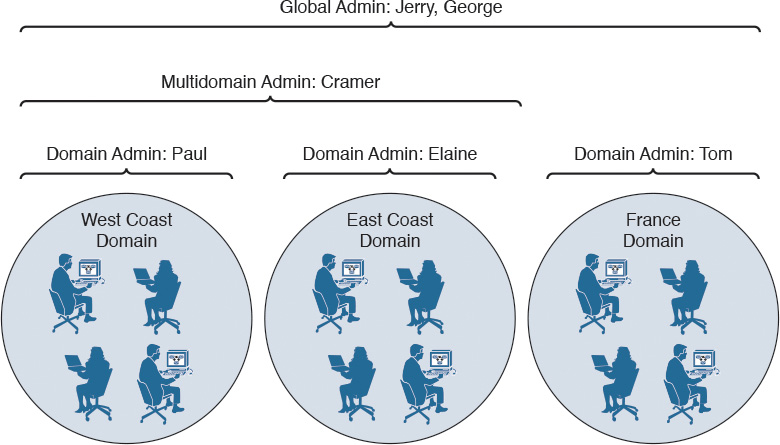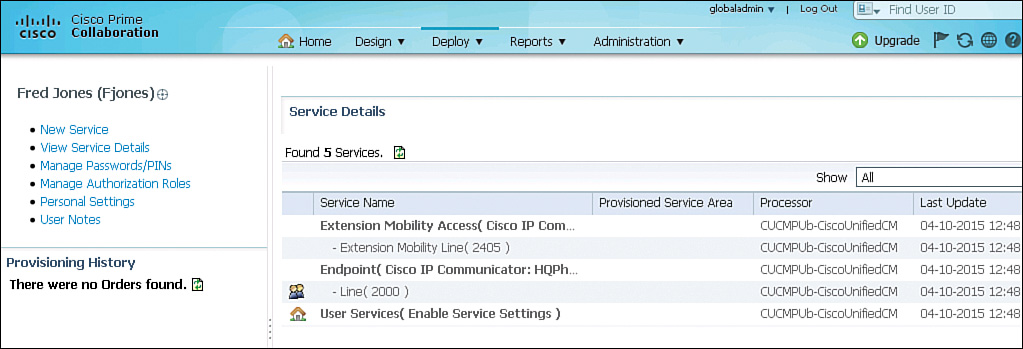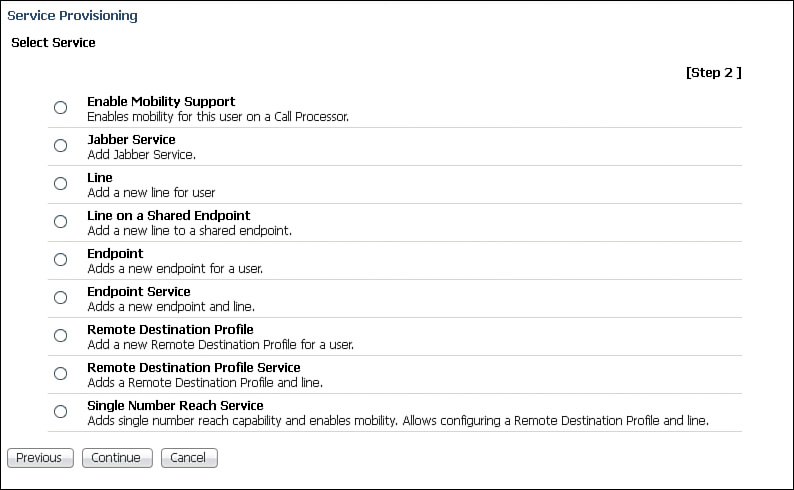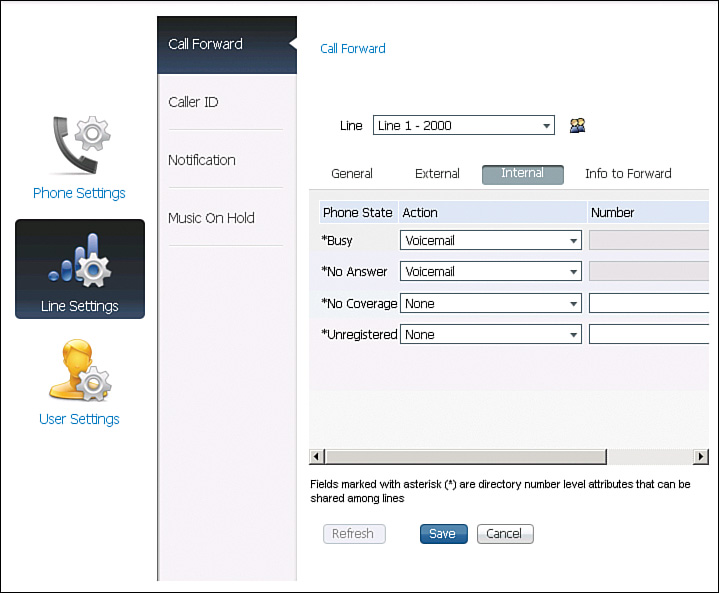Chapter 20. Deploying Cisco Collaboration Systems Applications with Cisco Prime™ Collaboration
Upon completing this chapter, you will be able to do the following:
![]() Describe Cisco Prime™ Collaboration and its modules and architecture
Describe Cisco Prime™ Collaboration and its modules and architecture
![]() Describe how the lifecycle management is done with Cisco Prime™ Collaboration
Describe how the lifecycle management is done with Cisco Prime™ Collaboration
![]() Describe the features that are available in Cisco Prime™ Collaboration Provisioning Standard and Advanced
Describe the features that are available in Cisco Prime™ Collaboration Provisioning Standard and Advanced
![]() Describe the automated system provisioning with Cisco Prime™ Collaboration
Describe the automated system provisioning with Cisco Prime™ Collaboration
![]() Describe how you can combine domains, service areas, and different subscriber types for automated provisioning
Describe how you can combine domains, service areas, and different subscriber types for automated provisioning
![]() Describe how different administrators can be set up to manage different domains
Describe how different administrators can be set up to manage different domains
![]() Describe the benefits of information synchronization from the LDAP server to the Cisco Prime™ Collaboration server
Describe the benefits of information synchronization from the LDAP server to the Cisco Prime™ Collaboration server
![]() Describe the subscriber roles in Cisco Prime™ Collaboration
Describe the subscriber roles in Cisco Prime™ Collaboration
![]() Describe the Day 1 and Day 2 activities, where Cisco Prime™ Collaboration helps you manage and automate these tasks
Describe the Day 1 and Day 2 activities, where Cisco Prime™ Collaboration helps you manage and automate these tasks
![]() Describe the Day 1 deployment option allowing you to quickly integrate and set up the Cisco Collaboration Systems applications
Describe the Day 1 deployment option allowing you to quickly integrate and set up the Cisco Collaboration Systems applications
![]() Describe the Day 2 services such as managing daily moves, adds, and changes
Describe the Day 2 services such as managing daily moves, adds, and changes
![]() Describe how Cisco Prime™ Collaboration offers on single interface to set up phones with lines, user, mailboxes, and features in one step
Describe how Cisco Prime™ Collaboration offers on single interface to set up phones with lines, user, mailboxes, and features in one step
![]() Describe the Cisco Prime™ Collaboration dashboard
Describe the Cisco Prime™ Collaboration dashboard
![]() Explain the Cisco Prime Telephone Self-Care portal and the options that a user can select and configure
Explain the Cisco Prime Telephone Self-Care portal and the options that a user can select and configure
This chapter introduces the Cisco Prime™ Collaboration modules and focuses on provisioning. Day 1 and Day 2 activities are described. The use of the design and deployment options in Cisco Prime™ Collaboration are discussed, and the Cisco Prime Telephone self-care portal is covered.
Cisco Prime™ Collaboration Overview
Figure 20-1 illustrates Cisco Prime™ Collaboration and its modules and architecture.
Cisco Prime™ Collaboration removes management complexity and provides automated, accelerated provisioning, real-time monitoring, proactive troubleshooting, and long-term trending and analytics in one integrated product. The solution delivers a premier operations experience through an intuitive user interface and optimized operator methodology, including automated workflows that ease implementation and ongoing administration.
Provisioning
![]() This module accelerates Cisco Collaboration Systems site rollouts and dramatically reduces time to perform user moves, adds, changes, and deletes (MACD).
This module accelerates Cisco Collaboration Systems site rollouts and dramatically reduces time to perform user moves, adds, changes, and deletes (MACD).
![]() This module also removes complexity and helps enable delegation to help desk personnel, which can lower operating expenses.
This module also removes complexity and helps enable delegation to help desk personnel, which can lower operating expenses.
Assurance
![]() This module helps ensure reliable service delivery through proactive fault detection and rapid isolation using purpose-built diagnostic tools.
This module helps ensure reliable service delivery through proactive fault detection and rapid isolation using purpose-built diagnostic tools.
![]() This module expedites operator resolution of service quality issues before these issues impact end users.
This module expedites operator resolution of service quality issues before these issues impact end users.
Analytics
![]() This module helps administrators analyze trends for capacity planning, resource optimization, and quality of service.
This module helps administrators analyze trends for capacity planning, resource optimization, and quality of service.
![]() This module quickly determines the success of advanced, collaboration technology adoption to advance future investment decisions.
This module quickly determines the success of advanced, collaboration technology adoption to advance future investment decisions.
Complete Lifecycle Management
Figure 20-2 describes how the lifecycle management is done with Cisco Prime™ Collaboration.
Cisco Prime™ Collaboration is a single product that is capable of managing all of your collaboration lifecycle needs. Cisco Prime™ Collaboration allows you to simplify and automate many day-to-day tasks as shown in the figure.
The Cisco Prime™ Collaboration menu controls navigation according to the stages in the lifecycle approach.
The graphical user interface (GUI) shows all menus because Cisco Prime™ Collaboration Provisioning and Assurance and converged:
![]() Home
Home
![]() Design
Design
![]() Deploy
Deploy
![]() Operate
Operate
![]() Analyze
Analyze
![]() Administration
Administration
You can use the GUI from each application separately or create a unified access. For example, if you access Cisco Prime™ Collaboration Provisioning directly, the menu might look different than when you use a unified access.
Cisco Prime™ Collaboration as a converged application combines the benefit of Assurance and Provisioning features. You can run Prime Collaboration as a converged application or as standalone applications.
![]() When you run the converged application, a single sign-on (SSO) is available to log in and access both Assurance and Provisioning features. You can access all Provisioning features from the Design and Deploy menus in the Home page.
When you run the converged application, a single sign-on (SSO) is available to log in and access both Assurance and Provisioning features. You can access all Provisioning features from the Design and Deploy menus in the Home page.
![]() When you run the components of Cisco Prime™ Collaboration as standalone applications, separate logins are available for the Assurance and Provisioning features.
When you run the components of Cisco Prime™ Collaboration as standalone applications, separate logins are available for the Assurance and Provisioning features.
Prime Collaboration allows you to integrate the Provisioning and Assurance applications and configure the Provisioning system from Assurance using SSO.
Note
In the converged mode, before you restart or shut down the Prime Collaboration Provisioning application, you must ensure that you detach it from Prime Collaboration Assurance and converge it after the restart process.
Cisco Prime™ Collaboration Standard and Advanced
Table 20-1 describes the features that are available in Cisco Prime™ Collaboration Provisioning versions of Standard and Advanced.
Cisco Prime™ Collaboration Provisioning Standard manages only one Cisco Unified Communications Manager cluster and one Cisco Unity Connection cluster. The standard version supports only Cisco Collaboration Systems products in Version 10.0. Other differentiators are as follows:
![]() Delegation of roles: The standard version allows three levels of RBAC: system level, advanced ordering level, and basic ordering level. The advanced version allows advanced RBAC and delegation. Administrators with ordering privileges can be assigned to different domain user groups.
Delegation of roles: The standard version allows three levels of RBAC: system level, advanced ordering level, and basic ordering level. The advanced version allows advanced RBAC and delegation. Administrators with ordering privileges can be assigned to different domain user groups.
![]() Ordering workflow roles: The advanced version provides ordering workflow, including optional stages between placing an order and the actual provisioning of the order: approver, assigner, shipper, and receiver. The activity roles can be enabled or disabled, and assigned to different users for an efficient ordering workflow.
Ordering workflow roles: The advanced version provides ordering workflow, including optional stages between placing an order and the actual provisioning of the order: approver, assigner, shipper, and receiver. The activity roles can be enabled or disabled, and assigned to different users for an efficient ordering workflow.
![]() Batch provisioning: The standard version allows you to deploy a large number of services by combining them into a single batch. Batch provisioning is available for a single cluster only. In the advanced version, a single provisioning batch can perform infrastructure and user provisioning across many Cisco Unified Communications Manager clusters, making Prime Collaboration batches global in scope.
Batch provisioning: The standard version allows you to deploy a large number of services by combining them into a single batch. Batch provisioning is available for a single cluster only. In the advanced version, a single provisioning batch can perform infrastructure and user provisioning across many Cisco Unified Communications Manager clusters, making Prime Collaboration batches global in scope.
![]() Infrastructure templates: Infrastructure templates are available only in the advanced version. Prime Collaboration Provisioning infrastructure templates can be created for Cisco Unified Communications Manager and Cisco IOS Software. These templates provide keyword support, which is not available in batch files, for repetitive tasks such as site rollouts. Templates can be scheduled for execution at a later time and are tracked in the order tracking system for auditing or troubleshooting at a later time. These templates can leverage Cisco IOS prebuilt templates with keyword support.
Infrastructure templates: Infrastructure templates are available only in the advanced version. Prime Collaboration Provisioning infrastructure templates can be created for Cisco Unified Communications Manager and Cisco IOS Software. These templates provide keyword support, which is not available in batch files, for repetitive tasks such as site rollouts. Templates can be scheduled for execution at a later time and are tracked in the order tracking system for auditing or troubleshooting at a later time. These templates can leverage Cisco IOS prebuilt templates with keyword support.
![]() API: This feature is available only in the advanced version. The Northbound API is supported for integration with third-party management applications, HR systems, or other custom provisioning interfaces.
API: This feature is available only in the advanced version. The Northbound API is supported for integration with third-party management applications, HR systems, or other custom provisioning interfaces.
Automated System Provisioning
Table 20-2 describes the automated system provisioning with Cisco Prime™ Collaboration.
With Cisco Prime™ Collaboration, you can automate provisioning. Provisioning is a web-based application based on the Java 2 Platform, Enterprise Edition (J2EE) architecture. Provisioning uses various interfaces to connect with Cisco Collaboration Systems applications, and does not need to deploy any agent software on those application platforms.
Provisioning uses open interfaces such as HTTP, HTTPS, AVVID XML Layer (AXL)–SOAP, SSH, and Telnet to remotely configure or query the applications that are being managed, as illustrated in Figure 20-3. Different levels of user access can be configured by the administrator.
Domains, Service Areas, and Subscriber Types
Figure 20-4 describes an example of how you can combine domains, service areas, and different subscriber types for automated provisioning.
Binding these entities together helps you to automate processes for groups, locations, and others to quickly deploy and manage the Cisco Collaboration Systems solution.
Domains
Domains are groupings of subscribers. For each grouping, one or more system users can be authorized to manage services for subscribers within that domain. In addition, rules or policies may be set on a domain; those rules and policies apply to services for subscribers in that domain. Common policies can also be applied on operations within a domain.
A user can manage more than one domain if the user is assigned the proper authorization role. All the user’s services are provisioned in the services domain that you specify while adding the user.
Service Area
Service areas are groupings within a domain that are used to structure and manage the required IP telephony and messaging services across geographic, organizational, or technological boundaries. The service area typically acts as a service offering location and provides a template mechanism that determines the provisioning attribute values that are used during order processing. The service area determines the mappings from the business view of the service to the technology that delivers those services.
A service area also manages Cisco Unified Communications Manager (CUCM) partitioning and class of service by controlling the location, device pool, calling search space (CSS), and route partition assignments for any device that is provisioned into that service area. For example, on a service area that is associated to a CUCM, the service area defines the device pool, route partition, CSSs, location, and external phone number mask that the products will use within CUCM.
Subscriber Types
Subscriber roles control the products and services that a subscriber can order. The subscriber role also dictates the service areas that a subscriber is entitled to access.
Administration Levels
Figure 20-5 describes how different administrators can be set up to manage different domains.
Administrators can only see the subscribers and resources in the domains to which they are assigned, and assignments can be added or removed easily by a global administrator.
There is some additional granularity in basic and advanced roles that can be performed by different administrator types beyond what is shown in the figure.
There are preconfigured roles for administrators (for example, infrastructure management roles or workflow admin roles).
LDAP Import
Figure 20-6 illustrates the benefits of information synchronization from two LDAP servers to the Cisco Prime™ Collaboration server with different domains.
Provisioning can use this information to create new subscribers, update existing subscriber information, or delete subscribers. You configure the LDAP server synchronization to determine which actions should be performed.
When provisioning new users in CUCM, you need to be sure that the user ID of the subscriber exactly matches the user ID in CUCM or the order will be rejected. Cisco Prime™ Collaboration can get Lightweight Directory Access Protocol (LDAP) subscribers from CUCM when CUCM is LDAP-integrated. This method is a pass-through method of synchronizing all LDAP subscribers that are known by CUCM.
With LDAP integration, Cisco Prime™ Collaboration can populate its subscriber database with user IDs directly from an associated LDAP source. A filter feature allows you to get only user IDs that belong in a specific domain, as opposed to importing the entire LDAP directory. An example of filtering is shown in the figure; for example, all users with the number 40852*****. Complex filters can be created based on the available fields in Active Directory.
There is an option that allows you to remove a user and their services from the Collaboration Systems network when a synchronization occurs and a user is no longer in the LDAP directory. Another option prevents a user from being deleted if they still have associated services. These optional settings can help remove unused services and free up directory numbers after employees leave a company.
Reports can also be generated showing the results of the import. Results can include new users, users that were removed, users who were deleted from CUCM, and users that need service cleanup before they are deleted.
If Cisco Prime™ Collaboration is used as the subscriber source, CUCM may not need to be LDAP enabled to ensure that only LDAP users are provisioned.
Subscriber Roles
Subscriber roles control the products and services that a subscriber can order. The subscriber role also dictates the service areas that a subscriber is entitled to access. Do not confuse subscribers with users. These two roles are different in Cisco Prime™ Collaboration.
The default subscriber types are as follows:
![]() Employee: This subscriber type is the default role that is assigned to new subscribers. The employee subscriber role should be configured to match the typical setup of employees in your organization. If you do not configure the employee subscriber role to meet your needs, you may not see all of the desired options in the employee subscriber record.
Employee: This subscriber type is the default role that is assigned to new subscribers. The employee subscriber role should be configured to match the typical setup of employees in your organization. If you do not configure the employee subscriber role to meet your needs, you may not see all of the desired options in the employee subscriber record.
![]() Pseudo: This subscriber type is used to provision phones that do not have an associated user. Pseudo subscribers cannot be renamed or removed.
Pseudo: This subscriber type is used to provision phones that do not have an associated user. Pseudo subscribers cannot be renamed or removed.
![]() Executive: This subscriber type is used for management of users with advanced communication requirements, for example video phones and international dialing.
Executive: This subscriber type is used for management of users with advanced communication requirements, for example video phones and international dialing.
These subscriber types exist in each domain in Cisco Prime™ Collaboration Provisioning. Each set of subscriber types can be customized in each domain by adding, removing, or changing these predefined subscriber types.
Deployment Aspects in Cisco Prime™ Collaboration
The following are the Day 1 and Day 2 activities, where Cisco Prime™ Collaboration helps you manage and automate these tasks.
![]() Day 1 activities:
Day 1 activities:
![]() Infrastructure configuration and batch provisioning
Infrastructure configuration and batch provisioning
![]() Unified Communication services
Unified Communication services
![]() Day 2 activities:
Day 2 activities:
![]() Subscriber management and services and self-care portal
Subscriber management and services and self-care portal
Provisioning features include automated processes for Cisco Collaboration Systems initial deployments and for Day 2 move, add, change, and deletes (MACDs). An intuitive user interface provides a single view of a subscriber and the subscriber’s services as well as a consolidated view of subscribers across the organization. With these capabilities, Cisco Prime™ Collaboration significantly accelerates site rollouts and dramatically reduces the time that is required for ongoing changes, resulting in exceptional productivity gains and lower operating expenses.
In addition, by significantly simplifying moves, adds, changes, and deletes, the solution facilitates delegation of these tasks. Delegation allows organizations to optimize IT resources and further reduce total cost of ownership. A self-care portal allows end users to control preference settings (for example, call forwarding, speed dials, and passwords, which helps create a better-quality user experience).
Cisco Prime™ Collaboration offers flexibility and awareness:
![]() Multicluster: Prime Collaboration can manage one or many clusters spread across one or many domain groups.
Multicluster: Prime Collaboration can manage one or many clusters spread across one or many domain groups.
![]() Multirevision: Prime Collaboration supports multiple versions of Cisco Collaboration Systems applications concurrently.
Multirevision: Prime Collaboration supports multiple versions of Cisco Collaboration Systems applications concurrently.
![]() Multi-application: Prime Collaboration supports mixes of call processors and message processors; for example, CUCM Express with Cisco Unity, or CUCM associated with Cisco Unity and Cisco Unity Connection, for example, in different versions.
Multi-application: Prime Collaboration supports mixes of call processors and message processors; for example, CUCM Express with Cisco Unity, or CUCM associated with Cisco Unity and Cisco Unity Connection, for example, in different versions.
![]() Service-aware: When adding voice mail, Cisco Prime™ Collaboration sets forwarding and extension settings automatically. When adding presence, the line is associated to the user ID.
Service-aware: When adding voice mail, Cisco Prime™ Collaboration sets forwarding and extension settings automatically. When adding presence, the line is associated to the user ID.
Day 1 Services Infrastructure
Cisco Unified Configurator for Collaboration or CUCC is a simple GUI-based configuration tool that helps partners with rapid deployment to increase margins and reduce operating expenses. CUCC is Day 1 configuration tool that shortens the UCM installation time and performs repeatable process to avoid common mistakes.
The following are the Day 1 deployment options allowing you to quickly integrate and set up the Cisco Collaboration Systems applications:
![]() Policy and service definitions
Policy and service definitions
![]() Create policies, policy-based service offerings, and subscriber types.
Create policies, policy-based service offerings, and subscriber types.
![]() Template-based infrastructure provisioning
Template-based infrastructure provisioning
![]() Push dial-plan components and other common constructs to end system.
Push dial-plan components and other common constructs to end system.
![]() Batch processing of total services for subscribers
Batch processing of total services for subscribers
![]() Bulk-create initial subscribers and provision their services.
Bulk-create initial subscribers and provision their services.
The Infrastructure Configuration page of Cisco Prime™ Collaboration enables you to browse the infrastructure configuration settings of a Call Processor and Unified Message Processor. Through this page, you can add, edit, or delete the configuration settings of a Call Processor and Unified Message Processor.
The configuration can be done from Cisco Prime™ Collaboration by selecting Deploy > Infrastructure Configuration and chosing the device (Cisco Collaboration Systems applications are called processors) you want to configure. Then select the parameter (for example, Route Pattern), as shown in Figure 20-7. Delete or modify existing route patterns or create new route patterns.
Day 2 Services
When the Cisco Collaboration Systems applications are integrated and set up, the Day 2 work begins. You configure new users and maintain the user database including user phones and features.
In Cisco Prime™ Collaboration, choose Deploy > User Provisioning. Choose a subscriber, for example Fred Jones, as shown in Figure 20-8. In the service details section, you can view the services that are assigned to the user. By choosing New Service, you can add a new device or feature for a user. All orders are logged so that you can track the changes that are done in the system very easily. You can also add notes to a subscriber, which helps you remember certain information for users.
Single Provisioning Interface
Figure 20-9 shows the orderable products (for example, a new phone and others). The figure does not show all options.
As an example, for user Fred Jones, you can configure several different user services, as shown in Figure 20-10.
Based on the subscriber type, you will get a list of selectable phones for a user. Administrators can select new endpoints (like Cisco Jabber for Tablet and others) and assign telephony features, in the same way as they can for Cisco IP phones.
Cisco Prime™ Collaboration Dashboard
Figure 20-11 illustrates the Cisco Prime™ Collaboration dashboard.
The Home dashboard allows you to view important statistics and details of the processors, pending orders, status of the device synchronization, domains and their deployment details, and users who are logged in as well as locked. The dashboards are available under Home.
You can see all of this information on a single page, instead of navigating through several pages. You can also click the links provided in the dashboard to view the relevant details.
A pie chart displays the details of the licensed and used voice terminals (phones). To view the pie chart, you must have Adobe Flash Player installed in your system. If it is not installed, you are prompted to install it.
Cisco Prime Telephone Self-Care
Figure 20-12 illustrates the Cisco Prime Telephone Self-Care portal and the options that a user can select and configure.
Figure 20-12 shows the phone settings of a user. To log in to Cisco Prime Telephone Self-Care, browse to the IP address of Cisco Prime™ Collaboration. Log in with the user credentials and configure the settings for the phone, line, or user. The options that the user sees and is able to configure depend on the Cisco Prime™ Collaboration setup. Users may configure speed dials, language settings, or enable services like Extension Mobility.
Figure 20-13 shows the line settings of a user. In the line settings, the user can configure call forward settings, caller ID, ringer notification and message waiting indicator (MWI), and others.
Figure 20-14 shows the user settings. In the User Settings area, select the Primary Device and set the PIN and password.
![]() Cisco Unified Configurator for Collaboration can help you quickly customize a new Cisco Collaboration Systems solution. The GUI tool works with templates, however, you need to have an understanding of Cisco Collaboration Systems applications and their configuration to use it.
Cisco Unified Configurator for Collaboration can help you quickly customize a new Cisco Collaboration Systems solution. The GUI tool works with templates, however, you need to have an understanding of Cisco Collaboration Systems applications and their configuration to use it.
![]() Cisco Prime™ Collaboration offers provisioning, assurance, and analytics modules. Cisco Prime™ Collaboration removes management complexity and provides automated provisioning, offers real-time monitoring, and long-term trending and analytics.
Cisco Prime™ Collaboration offers provisioning, assurance, and analytics modules. Cisco Prime™ Collaboration removes management complexity and provides automated provisioning, offers real-time monitoring, and long-term trending and analytics.
![]() With the default subscriber types, you can predefine a set of options, products, and features that you want to deploy, for example, for the employee or executive level.
With the default subscriber types, you can predefine a set of options, products, and features that you want to deploy, for example, for the employee or executive level.
![]() Cisco Prime™ Collaboration allows you to manage Day 1 activities like infrastructure configuration and Day 2 activities like MACD.
Cisco Prime™ Collaboration allows you to manage Day 1 activities like infrastructure configuration and Day 2 activities like MACD.
![]() Enable the Telephone Self-Care feature to allow users to configure device, line, and user settings in Cisco Prime™ Collaboration to free the administrator from daily configuration requests and to create a better-quality user experience.
Enable the Telephone Self-Care feature to allow users to configure device, line, and user settings in Cisco Prime™ Collaboration to free the administrator from daily configuration requests and to create a better-quality user experience.
The chapter described Cisco Prime™ Collaboration provisioning and how it can be used for Day 1 activities, like setting up the infrastructure, and Day 2 activities, such as daily moves, adds, changes, and deletions.
Review Questions
Answer the following questions, and then see Appendix A, “Answers to Review Questions,” for the answers.
1. Cisco Unified Configurator for Collaboration is used for Day 1 activities.
a. True
b. False
2. Which option is not a Cisco Prime™ Collaboration module?
a. Assurance
b. Analytics
c. Monitoring
d. Provisioning
3. To manage multiple Unified Communications clusters in different versions you need the Cisco Prime™ Collaboration Advanced license.
a. True
b. False
4. Which option is not a default subscriber type in Cisco Prime™ Collaboration?
a. Employee
b. Executive
c. Manager
d. Pseudo
5. Which service creates a phone with a line, including voice mail, and a set of voice services?
a. Endpoint Service
b. Enhanced Endpoint Service
c. User Service

